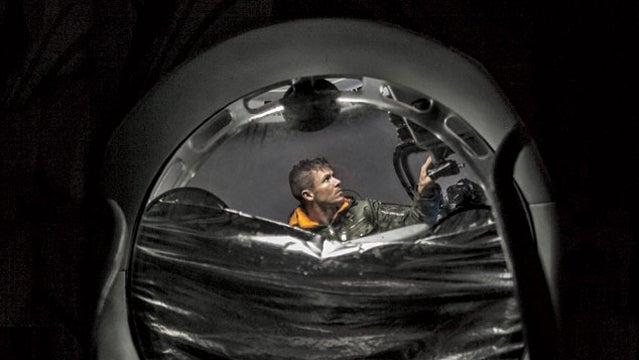The Stuntmen: James Cameron and Felix Baumgartner
On March 26, 2012, director James Cameron piloted his mini sub, the Deepsea Challenger—which he designed with engineer Ron Allum—to the deepest spot in the ocean, the 6.8–mile-down Mariana Trench. It was only the second time mankind had reached that depth, after Don Walsh and Jacques Piccard made the trip in 1960 in the U.S. Navy’s hollow-steel bathyscaphe Trieste. Meanwhile, on October 14, Felix Baumgartner, the Austrian skydiver, stepped out of a steel capsule and fell to earth from the stratosphere, topping the previous record for highest parachute jump, which was set by Air Force colonel Joe Kittinger in 1960. Bold projects like this used to be possible only through government funding. Now the adventure world is dominated by individuals and companies with deep pockets.
Click through to compare Felix’s jump with James’s dive.
�����ԹϺ���r of the Year: Supersonic Man Felix Baumgartner
The 5 stages of jumping from space

127,852.4 feet: After a massive helium balloon lifts him 24 miles high, Baumgartner opens the hatch to his eight-foot-diameter capsule and launches into the stratosphere.
91,316 feet: Fifty seconds into free fall, Baumgartner reaches his top speed of 843.6 miles per hour and becomes the first person to break the sound barrier with his body, that’s caught on amateur video from the ground.
75,000 feet: Baumgartner enters into an uncontrolled flat spin—one of the greatest concerns going into the mission, since G forces can cause blackouts. After 13 seconds he regains control.
8,400 feet: Baumgartner pulls his chute after four minutes and 20 seconds of free fall.
Touchdown: Forty-five miles east of Roswell, New Mexico, Baumgartner lands safely, drops to his knees, and raises a hand in triumph for the cameras.
For more, read Ryan Krogh’s feature story Bull Shot.
The Stuntmen: James’s Dive
The 5 stages of a deep, deep sea dive

Sea level: Two hundred miles off the coast of Guam, Cameron’s support vessel winches the 24-foot Deepsea Challenger into the Pacific.
650 feet: Descending at a rate of eight feet per second, the Challenger moves through the sunlight zone, where most ocean life resides, and into the twilight zone, where light fades and bioluminescent creatures like lanternfish live.
13,000 feet: Lights out—Cameron enters the pitch-black abyssal zone.
19,700 feet: Three-quarters of the ocean floor lies at this depth. The only deeper points are its trenches.
Touchdown: Two hours and 36 minutes after beginning his dive, Cameron arrives at 35,756 feet, where water pressure is 16,000 pounds per square inch. Before collecting sediment samples for analysis, Cameron sends out a tweet: “Just arrived at the ocean’s deepest pt. Hitting bottom never felt so good.”


